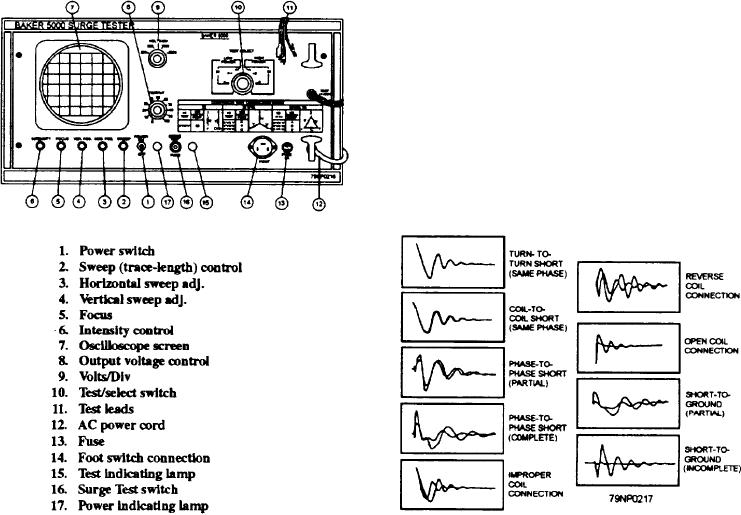
or more turns of bare wire around the commutator.
the insulation, it is considered a destructive test and
should be performed only when necessary.
Then, apply the high-potential test voltage across the
common connection of all the commutator segments
The application of each high-potential test tends to
and the grounded armature shaft.
weaken insulation even though it does not produce
A high-potential test should not be made on any
actual failure at the time. Also, the use of high-potential
equipment until the insulation resistance has been
tests requires special equipment and safety precautions.
measured and found to be satisfactory as per NSTM,
When making high-potential tests on electrical
chapter 300.
equipment that has been reconditioned or rewound in a
shop, you should NOT come in contact with any part of
Surge Comparison Test
the circuit or apparatus. Never touch the winding after
a high-potential test has been made until it has been
The surge comparison tester (figs. 7-47 and 7-48)
connectd to ground to remove any static charge it may
uses the principle of impedance balance to
have retained.
simultaneously test turn-to-turn, coil-to-coil,
phase-to-phase, and coil-to-ground insulation; in
Connect all leads to the circuit being tested to one
addition, qualitative evaluations are made of a winding's
terminal of the source of test voltage. All the leads to
likelihood of satisfactorily passing resistance,
all the other circuits and all metal parts should be
impedance, turn balance, and high-potential tests.
connected to ground to shunt the voltage produced by
transformer action. No leads are to be left unconnected
Resistance Balance Test
for a high-potential test as this may cause an extremely
severe strain at some point of the winding. For example,
Using a Wheatstone bridge (fig. 7-9) or a digital
to make a high-potential test on a rewound armature,
voltmeter (fig. 7-50), the resistances of the windings are
short-circuit the commutator segments by wrapping one
measured very accurate] y to determine whether the
phases are electrically balanced.
The lowest resistance readings are subtracted from
the highest resistance readings. This number is
compared to 5% of the highest resistance reading. If the
difference is lower than 5% of the highest resistance
reading the windings are said to be electrically balanced.
ARMATURE REWINDING
Once an armature has tested bad and been
disassembled, the process of rewinding it can begin.
Figure 7-48.--Representative surge test waveforms.
Figure 7-47.--Baker 5000 Surge Comparison Tester.
7-34

